目录
一、功能实现............................................................................................... 2
二、源代码................................................................................................... 2
2.1 顶层图设计.................................................................................... 2
2.2 时钟分频模块................................................................................ 2
2.3 秒计时模块.................................................................................... 3
2.4 分计时模块.................................................................................... 4
2.5 时计时模块.................................................................................... 6
2.6 置数模块........................................................................................ 7
2.7 按键消抖模块................................................................................ 9
2.8 报时模块...................................................................................... 11
2.9 LED 灯管显示模块.......................................................................13
三、仿真..................................................................................................... 15
3.1 时钟 19:59:58 仿真...................................................................... 15
3.2 时钟 23:59:58 仿真...................................................................... 15
四、下载验证............................................................................................. 16
4.1 管脚设计图.................................................................................. 16
4.2 编译结果图.................................................................................. 16
4.3 下载验证图.................................................................................. 17
�
一、功能实现
1. 时分秒时钟显示;
2. 定点报时功能,x 点钟报时 x 次;
3. 时钟清零。按下按钮就可使时钟时、分、秒数字请零;
4. 按键消抖功能;
5. 置数功能。能够通过按按钮对时、分、秒进行置数。
二、源代码
2.1 顶层图设计
2.2 时钟分频模块
LIBRARY IEEE;
USE IEEE.STD_LOGIC_1164.ALL;
USE IEEE.STD_LOGIC_ARITH.ALL;
USE IEEE.STD_LOGIC_UNSIGNED.ALL;
entity clk_sourse is
port(
clk:in std_logic;
clk2:out std_logic;
clk3:out std_logic
�
);
end clk_sourse;
architecture a of clk_sourse is
signal clk0:std_logic;
signal clk1:std_logic;
begin
clk2<=clk1;
clk3<=clk0;
process(clk)
variable cnt:integer range 0 to 50000000;
variable cnt1:integer range 0 to 5000;
begin
if(clk'event and clk='1')then
cnt:=cnt+1;
cnt1:=cnt1+1;
if(cnt=50000000)then
clk1<=not clk1;
cnt:=0;
end if;
if(cnt1=5000)then
clk0<=not clk0;
cnt1:=0;
end if;
end if;
end process;
end a;
2.3 秒计时模块
LIBRARY IEEE;
USE IEEE.STD_LOGIC_1164.ALL;
USE IEEE.STD_LOGIC_ARITH.ALL;
USE IEEE.STD_LOGIC_UNSIGNED.ALL;
entity counter1 is
port(
clk:in std_logic;
clr:in std_logic;
key1:in std_logic;
min:out std_logic;
chg0:in std_logic_vector(3 downto 0);
chg1:in std_logic_vector(3 downto 0);
data0:out std_logic_vector(3 downto 0);
data1:out std_logic_vector(3 downto 0)
�
);
end counter1;
architecture a of counter1 is
signal cnt0:std_logic_vector(3 downto 0):="0000";
signal cnt1:std_logic_vector(3 downto 0):="0000";
begin
process(clk,clr,key1)
begin
if(clr='1' and key1='1')then
if(clk'event and clk='1')then
cnt0<=cnt0+1;
if(cnt0=9)then
cnt0<="0000";
cnt1<=cnt1+1;
end if;
if(cnt1=5 and cnt0=9)then
cnt0<="0000";
cnt1<="0000";
min<='1';
else
min<='0';
elsif(clr='0' and key1='1')then
elsif(key1='0' and clr='1')then
end if;
end if;
cnt0<="0000";
cnt1<="0000";
cnt0<=chg0;
cnt1<=chg1;
else
null;
end if;
data0<=cnt0;
data1<=cnt1;
end process;
end a;
2.4 分计时模块
LIBRARY IEEE;
USE IEEE.STD_LOGIC_1164.ALL;
USE IEEE.STD_LOGIC_ARITH.ALL;
�
USE IEEE.STD_LOGIC_UNSIGNED.ALL;
entity counter2 is
port(
clk:in std_logic;
clr,key1:in std_logic;--reset
hour:out std_logic;
chg2:in std_logic_vector(3 downto 0);
chg3:in std_logic_vector(3 downto 0);
data2:out std_logic_vector(3 downto 0);
data3:out std_logic_vector(3 downto 0)
);
end counter2;
architecture a of counter2 is
signal cnt0:std_logic_vector(3 downto 0):="0000";--9
signal cnt1:std_logic_vector(3 downto 0):="0000";--1
begin
process(clk,clr,key1)
begin
if(clr='1' and key1='1')then
if(clk'event and clk='1')then
cnt0<=cnt0+1;
if(cnt0=9)then
cnt0<="0000";
cnt1<=cnt1+1;
end if;
if(cnt1=5 and cnt0=9)then
cnt0<="0000";
cnt1<="0000";
hour<='1';
else
hour<='0';
elsif(clr='0' and key1='1')then
elsif(key1='0' and clr='1')then
end if;
end if;
cnt0<="0000";
cnt1<="0000";
hour<='0';
cnt0<=chg2;
cnt1<=chg3;
else
null;
�
end if;
data2<=cnt0;
data3<=cnt1;
end process;
end a;
2.5 时计时模块
LIBRARY IEEE;
USE IEEE.STD_LOGIC_1164.ALL;
USE IEEE.STD_LOGIC_ARITH.ALL;
USE IEEE.STD_LOGIC_UNSIGNED.ALL;
entity counter3 is
port(
clk:in std_logic;
clr,key1:in std_logic;
chg4,chg5:in std_logic_vector(3 downto 0);
key2:in std_logic;
data4:out std_logic_vector(3 downto 0);
data5:out std_logic_vector(3 downto 0)
);
end counter3;
architecture a of counter3 is
signal cnt0:std_logic_vector(3 downto 0):="0000";--hour gewei
signal cnt1:std_logic_vector(3 downto 0):="0000";--hour shiwei
begin
process(clk,clr,key1,key2)
begin
if(clr='1' and key1='1' and key2='1')then
if(clk'event and clk='1')then
cnt0<=cnt0+1;
if(cnt0=9)then
cnt0<="0000";
cnt1<=cnt1+1;
end if;
if(cnt1=2 and cnt0=3)then
cnt0<="0000";
cnt1<="0000";
end if;
end if;
elsif(clr='0' and key1='1' and key2='1')then
cnt0<="0000";
�
elsif(key1='0' and key2='0' and clr='1')then
cnt1<="0000";
cnt0<=chg4;
cnt1<=chg5;
else
null;
end if;
data4<=cnt0;--ge
data5<=cnt1;--shi
end process;
end a;
2.6 置数模块
LIBRARY IEEE;
USE IEEE.STD_LOGIC_1164.ALL;
USE IEEE.STD_LOGIC_ARITH.ALL;
USE IEEE.STD_LOGIC_UNSIGNED.ALL;
entity chgclk is
port(
clk:in std_logic;
key1,key2,clr:in std_logic;--add,mode
t:out std_logic_vector(1 downto 0);--testport
clk2:out std_logic;
cdata0:out std_logic_vector(3 downto 0);
cdata1:out std_logic_vector(3 downto 0);
cdata2:out std_logic_vector(3 downto 0);
cdata3:out std_logic_vector(3 downto 0);
cdata4:out std_logic_vector(3 downto 0);
cdata5:out std_logic_vector(3 downto 0)
);
end chgclk;
--
--
architecture a of chgclk is
signal cnt0:std_logic_vector(3 downto 0):="0000";
signal cnt1:std_logic_vector(3 downto 0):="0000";
signal cnt2:std_logic_vector(3 downto 0):="0000";
signal cnt3:std_logic_vector(3 downto 0):="0000";
signal cnt4:std_logic_vector(3 downto 0):="0000";
signal cnt5:std_logic_vector(3 downto 0):="0000";
signal clk1:std_logic:='0';
begin
process(clk)
�
variable clkcnt:integer range 0 to 1000;--test
begin
if(clk'event and clk='1')then
clkcnt:=clkcnt+1;
if(clkcnt=1000)then--test
clk1<=not clk1;
clk2<=clk1;--test
clkcnt:=0;
end if;
--
end if;
end process;
process(clk1,key1,key2,clr)--change
begin
if(clr='1')then
if(key1='0' and key2='1')then
if(clk1'event and clk1='1')then
cnt0<=cnt0+1;
if(cnt0=9)then
cnt0<="0000";
cnt1<=cnt1+1;
end if;
if(cnt1=5 and cnt0=9)then
cnt0<="0000";
cnt1<="0000";
end if;
end if;
cdata0<=cnt0;
cdata1<=cnt1;
elsif(key1='1' and key2='0')then
if(clk1'event and clk1='1')then
cnt2<=cnt2+1;
if(cnt2=9)then
cnt2<="0000";
cnt3<=cnt3+1;
end if;
if(cnt3=5 and cnt2=9)then
cnt2<="0000";
cnt3<="0000";
end if;
end if;
cdata2<=cnt2;
cdata3<=cnt3;
elsif(key1='0' and key2='0')then
�
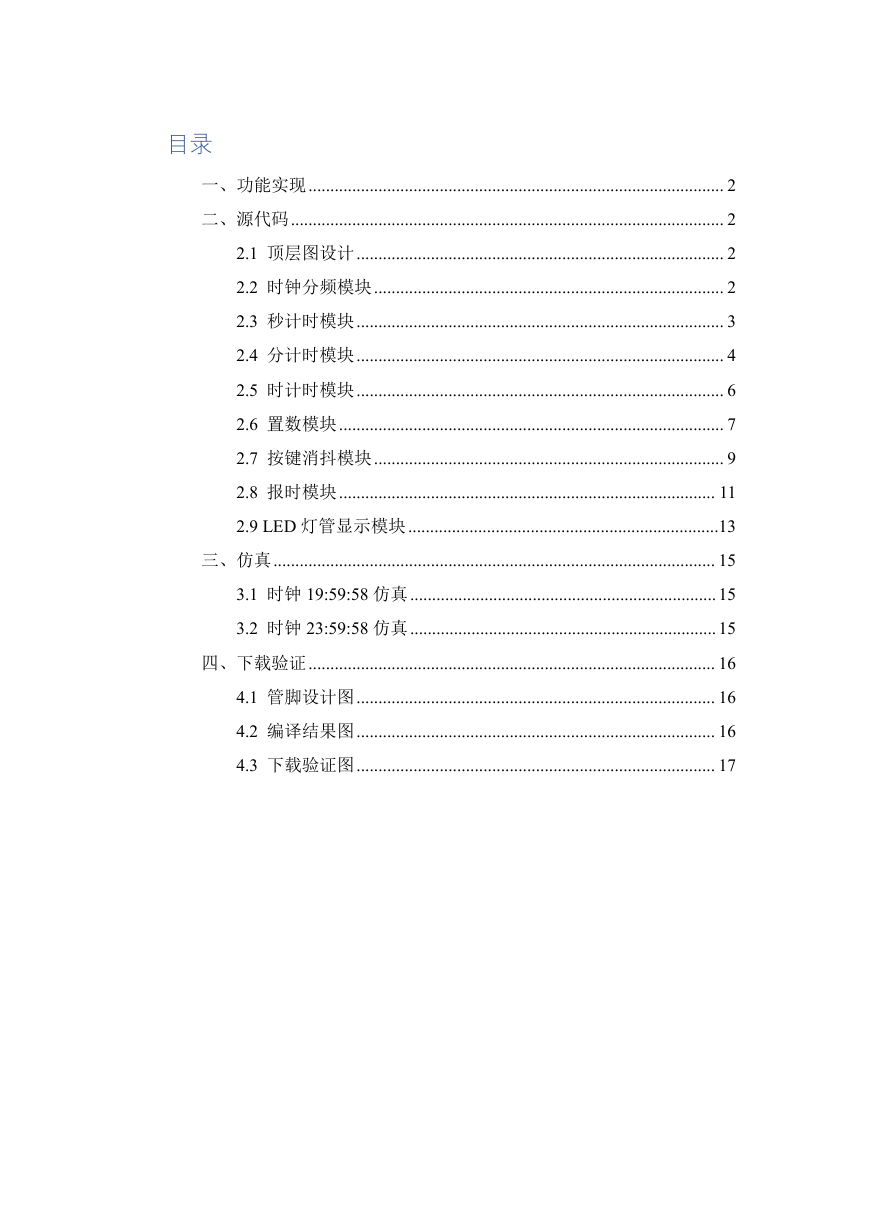
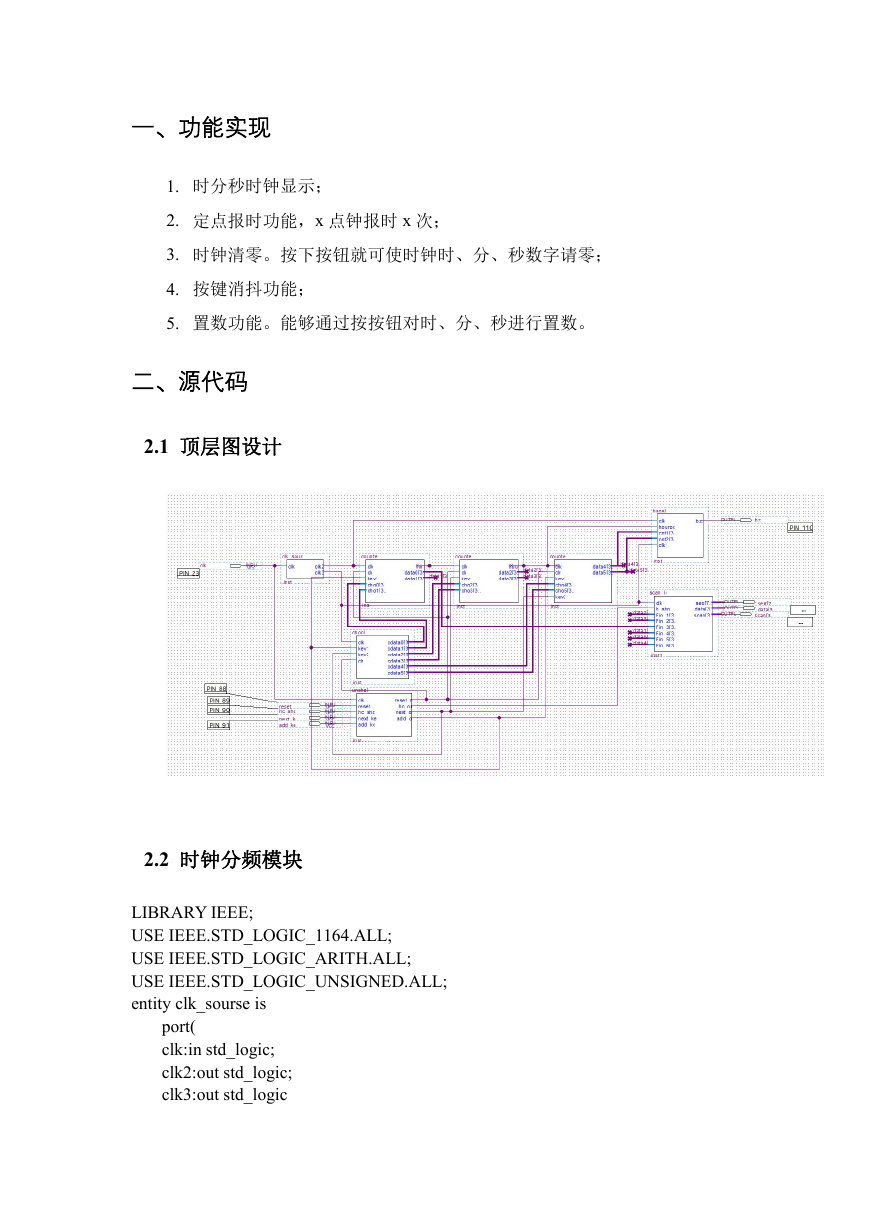

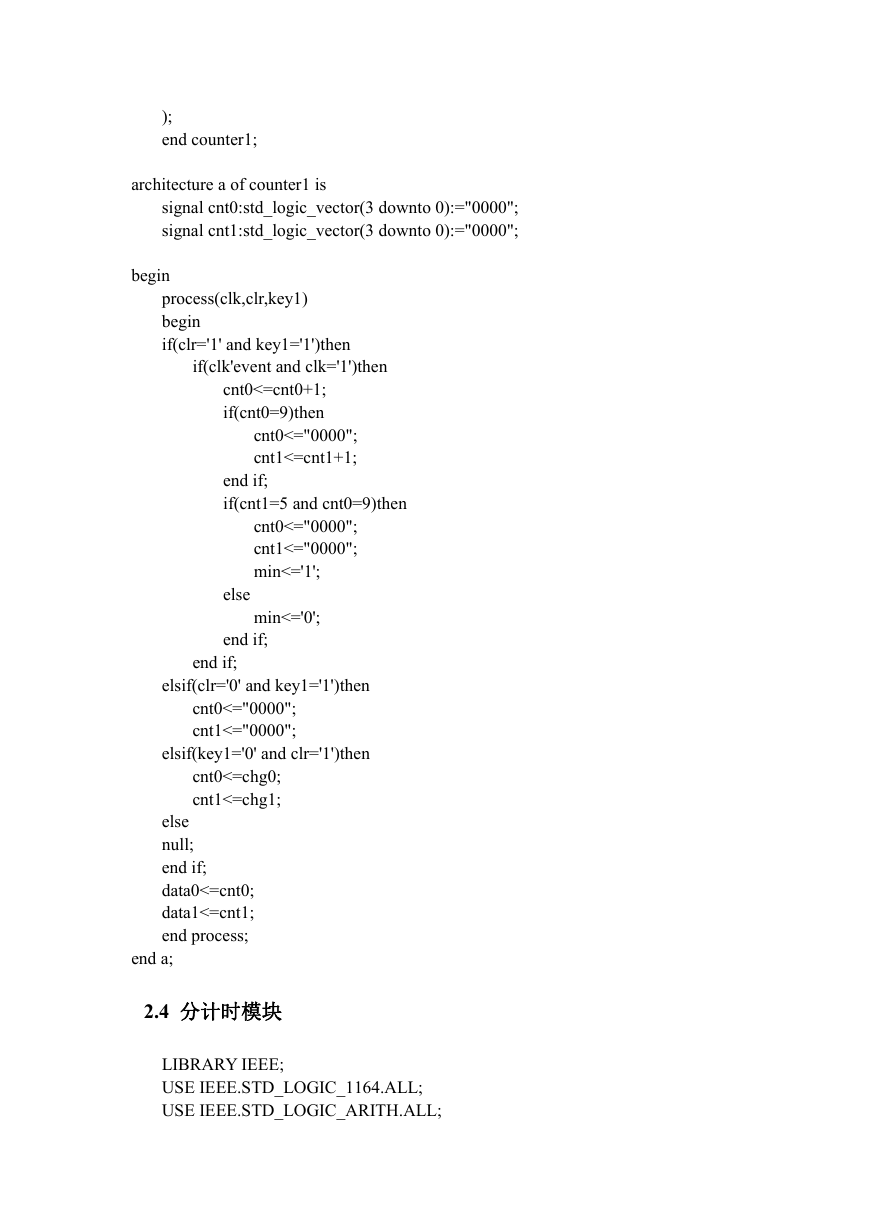
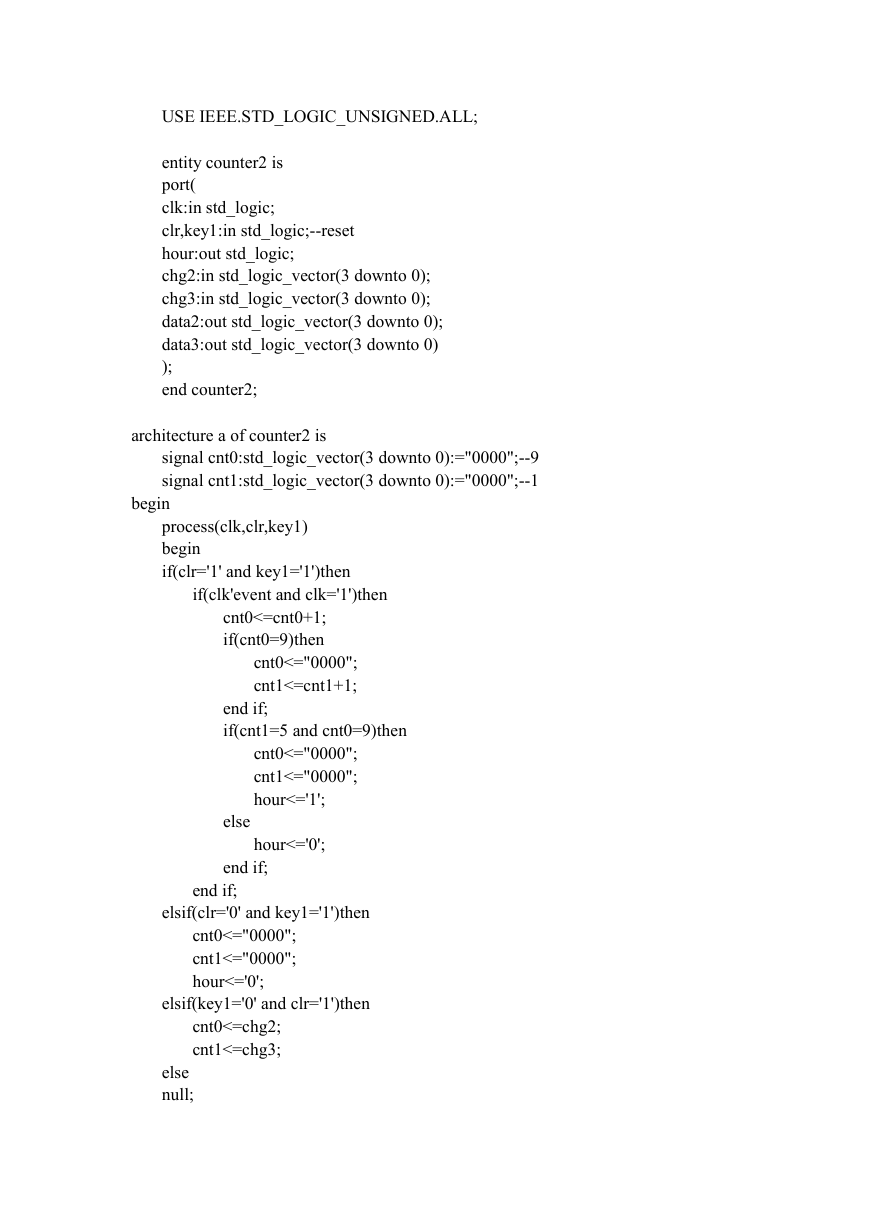

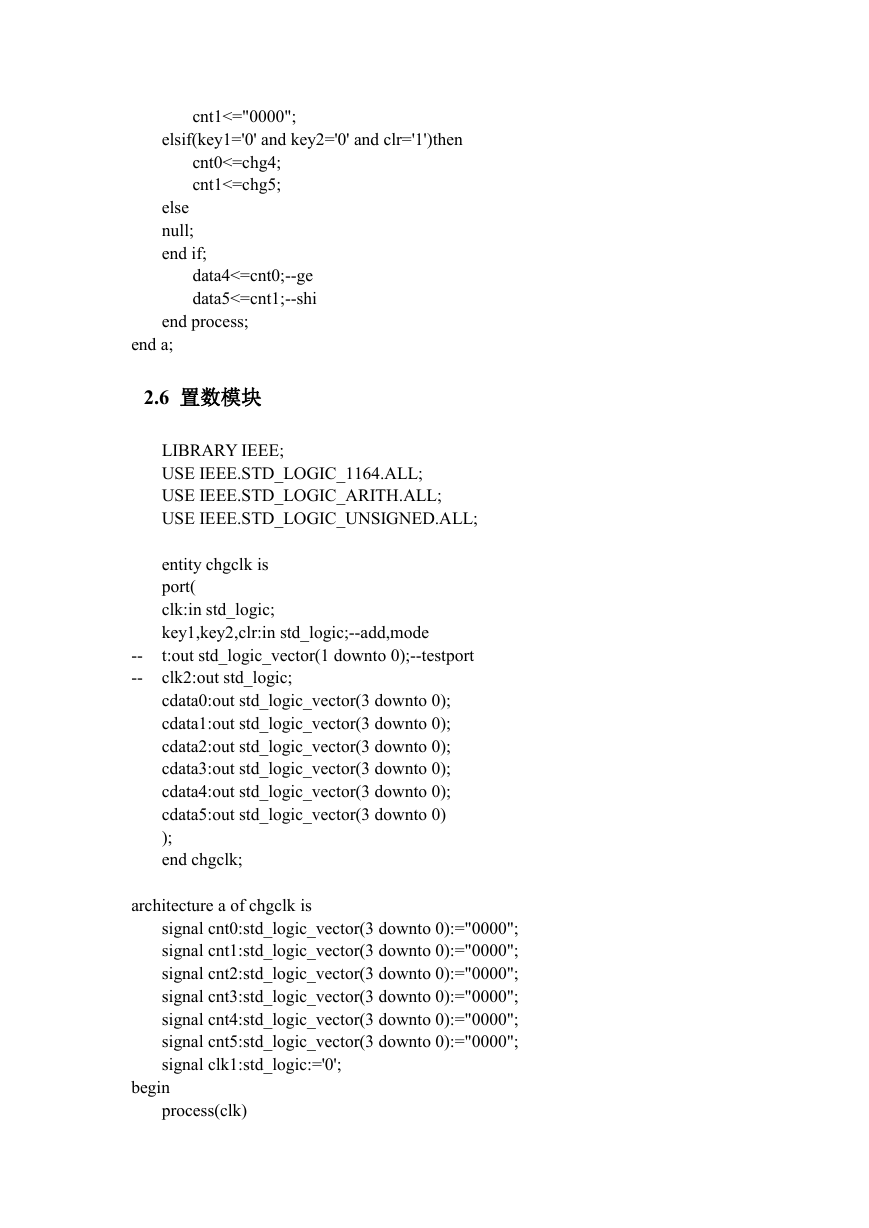
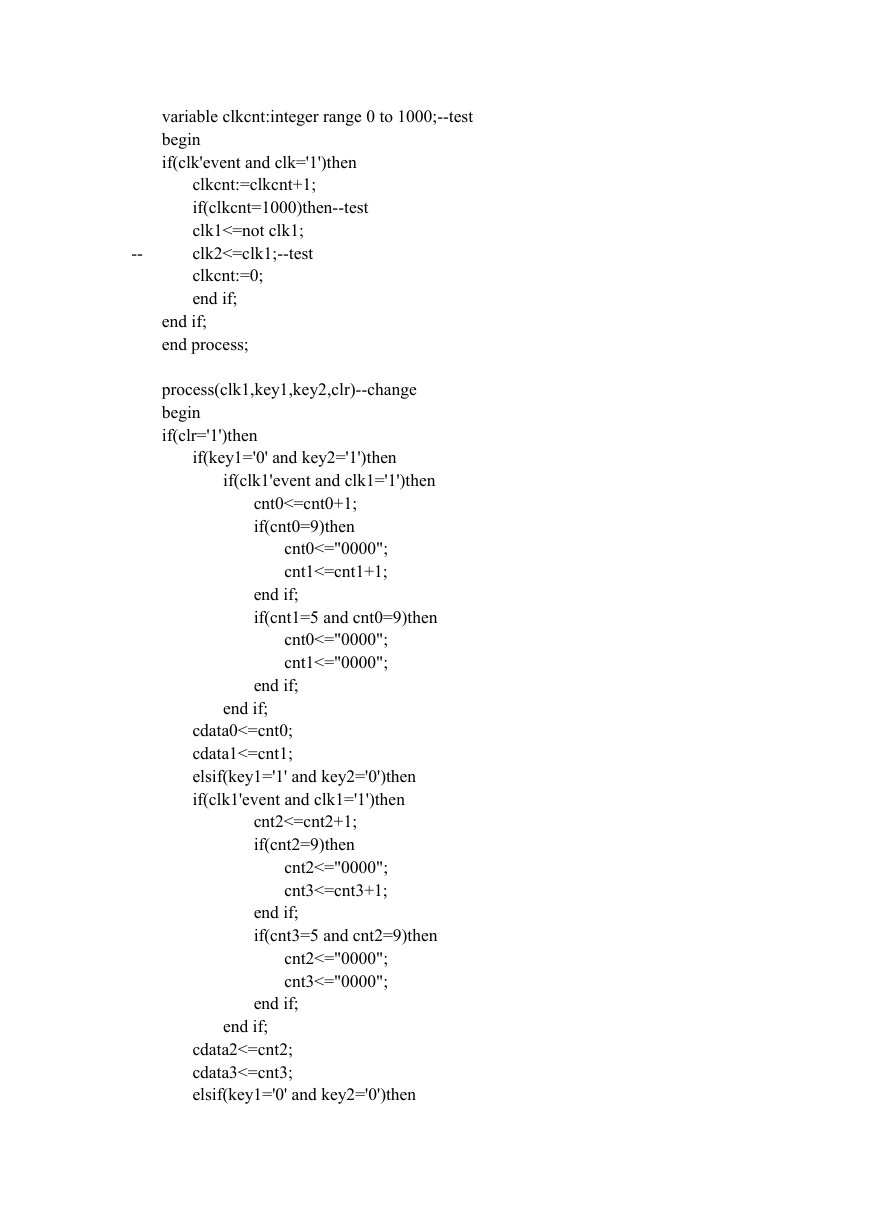








 2023年江西萍乡中考道德与法治真题及答案.doc
2023年江西萍乡中考道德与法治真题及答案.doc 2012年重庆南川中考生物真题及答案.doc
2012年重庆南川中考生物真题及答案.doc 2013年江西师范大学地理学综合及文艺理论基础考研真题.doc
2013年江西师范大学地理学综合及文艺理论基础考研真题.doc 2020年四川甘孜小升初语文真题及答案I卷.doc
2020年四川甘孜小升初语文真题及答案I卷.doc 2020年注册岩土工程师专业基础考试真题及答案.doc
2020年注册岩土工程师专业基础考试真题及答案.doc 2023-2024学年福建省厦门市九年级上学期数学月考试题及答案.doc
2023-2024学年福建省厦门市九年级上学期数学月考试题及答案.doc 2021-2022学年辽宁省沈阳市大东区九年级上学期语文期末试题及答案.doc
2021-2022学年辽宁省沈阳市大东区九年级上学期语文期末试题及答案.doc 2022-2023学年北京东城区初三第一学期物理期末试卷及答案.doc
2022-2023学年北京东城区初三第一学期物理期末试卷及答案.doc 2018上半年江西教师资格初中地理学科知识与教学能力真题及答案.doc
2018上半年江西教师资格初中地理学科知识与教学能力真题及答案.doc 2012年河北国家公务员申论考试真题及答案-省级.doc
2012年河北国家公务员申论考试真题及答案-省级.doc 2020-2021学年江苏省扬州市江都区邵樊片九年级上学期数学第一次质量检测试题及答案.doc
2020-2021学年江苏省扬州市江都区邵樊片九年级上学期数学第一次质量检测试题及答案.doc 2022下半年黑龙江教师资格证中学综合素质真题及答案.doc
2022下半年黑龙江教师资格证中学综合素质真题及答案.doc